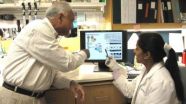Research reveals true value of cover crops to farmers, environment
2014-03-19
(Press-News.org) Planting cover crops in rotation between cash crops -- widely agreed to be ecologically beneficial -- is even more valuable than previously thought, according to a team of agronomists, entomologists, agroecologists, horticulturists and biogeochemists from Penn State's College of Agricultural Sciences.
"As society places increasing demands on agricultural land beyond food production to include ecosystem services, we needed a new way to evaluate 'success' in agriculture," said Jason Kaye, professor of biogeochemistry. "This research presents a framework for considering a suite of ecosystem services that could be derived from agricultural land, and how cover crops affect that suite of services.
"Cover cropping is one of the most rapidly growing soil and water conservation strategies in the Chesapeake Bay region and one we are really counting on for future improvements in water quality in the bay. Our analysis shows how the effort to improve water quality with cover crops will affect other ecosystem services that we expect from agricultural land."
The research, published in the March issue of Agricultural Systems, quantified the benefits offered by cover crops across more than 10 ecosystem services. Benefits included increased carbon and nitrogen in soils, erosion prevention, more mycorrhizal colonization -- beneficial soil fungus that helps plants absorb nutrients -- and weed suppression.
Lead researcher Meagan Schipanski explained that commonly used measurements of ecosystem services can be misleading due to the episodic nature of some services and the time sensitivity of management windows.
"For example, nutrient-retention benefits occur primarily during cover crop growth, weed-suppression benefits occur during cash-crop growth through a cover crop legacy effect, and soil-carbon benefits accrue slowly over decades," she said. "By integrating a suite of ecosystem services into a unified analytical framework, we highlighted the potential for cover crops to influence a wide array of ecosystem services. We estimated that cover crops increased eight of 11 ecosystem services. In addition, we demonstrated the importance of considering temporal dynamics when assessing management system effects on ecosystem services."
Trade-offs occurred between economic metrics and environmental benefits, said Schipanski, who was a postdoctoral scholar at Penn State when she led the cover crop study. Now an assistant professor in the department of soil and crop sciences at Colorado State University, she noted that the planting of cover crops will become more attractive if fertilizer prices rise or if modest cost-sharing programs like the one currently in place in Maryland are developed.
Researchers simulated a three-year, soybean-wheat-corn rotation with and without cover crops in central Pennsylvania, which presented agroecological conditions broadly representative of the Northeast and mid-Atlantic regions. The cover crop rotation included red clover, frost-seeded into winter wheat in March, and winter rye, planted after corn was harvested in the fall. The research, funded by the U.S. Department of Agriculture, used simulated management practices, including tillage, synthetic fertilizer use and mechanical weed control.
The planting of cover crops already is accepted as an environmentally prudent practice. It is so beneficial, in fact, that the National Resource Conservation Service last month set a goal to increase the acres planted nationally in cover crops from the current 2 million to 20 million by 2020.
According to NRCS, in 2006 only 5 percent of cropped acres in the Chesapeake Bay region had cover crops planted every year, and 88 percent of acres never had any cover crops planted. In 2011, 52 percent of acres had cover crops planted at least once every four years, and 18 percent of acres had cover crops planted every year. The NRCS estimated that the increased annual use of cover crops in 2011 led to an average 78 percent reduction in sediment loss, 35 percent less nitrogen surface loss, a 40 percent cut in nitrogen subsurface loss, and a 30 percent decrease in total phosphorus loss.
But many farmers have not planted cover crops because they have not seen financial incentives to do so, according to Kaye. That is largely because the traditional method of calculating the economic value of cover crops used by agricultural producers -- only estimating the resulting increase to cash-crop yields over a short period -- was not compelling.
"The most common metrics for evaluating cropping systems are grain and forage yields and short-term profitability," he said. "Within this context, cover crops are treated as a tool to be used only if they do not interfere with cash-crop production."
INFORMATION:
In addition to Schipanski and Kaye, the researchers included Mary Barbercheck, professor of entomology; Margaret Douglas, doctoral candidate in entomology; Denise Finney, doctoral candidate in ecology; Kristin Haider, former master's degree student in plant science; Armen Kemanian, assistant professor of plant science; David Mortensen, professor of weed ecology; Matthew Ryan, former postdoctoral scholar at Penn State and now assistant professor at Cornell University; John Tooker, assistant professor of entomology; and Charles White, extension associate in entomology.
ELSE PRESS RELEASES FROM THIS DATE:
Researchers identify potential new therapeutic target for controlling high blood sugar
2014-03-19
DALLAS – March 19, 2014 – A UT Southwestern Medical Center study has identified a new potential therapeutic target for controlling high blood sugar, a finding that could help the estimated 25 million Americans with type 2 diabetes.
Researchers showed that lipid molecules called phosphatidic acids enhance glucose production in the liver. These findings suggest that inhibiting or reducing production of phosphatidic acids may do the opposite.
“This study establishes a role for phosphatidic acids in enhancing glucose production by the liver and identifies enzymes involved ...
NASA sees ex-Tropical Cyclone Gillian affect Indonesia
2014-03-19
The remnants of former Tropical Cyclone Gillian moved out of the Southern Pacific Ocean and into the Indian Ocean only to trigger warnings and watches for part of Indonesia on March 19. NASA's Aqua satellite passed over the stubborn storm and took a visible image of the re-organizing tropical low pressure area.
NASA's Aqua satellite passed over Gillian's remnants on March 19 at 05:30 UTC/1:30 a.m. EDT and the Moderate Resolution Imaging Spectroradiometer or MODIS instrument took a visible picture of the storm. The image showed that the storm appeared to be well-defined, ...
Satellite sees newborn So. Pacific Tropical Storm Mike
2014-03-19
NOAA's GOES-West satellite caught the birth of Tropical Storm Mike in the Southern Pacific Ocean on March 19. Mike's formation has generated warnings for the Southern Cook Islands.
NOAA's GOES-West or GOES-15 satellite captured an infrared image of newborn Tropical Storm Mike in the Southwestern Pacific Ocean on March 19 at 1200 UTC/8 a.m. EDT. Mike appeared to be a compact, rounded tropical storm with bands of thunderstorms wrapping into it. NOAA's GOES-West satellite sits in a fixed orbit in space capturing visible and infrared imagery of all weather over the western ...
The scientific legacy of colonialism in Africa
2014-03-19
Colonial legacy has a significant impact on scientific productivity across the continent of Africa, according to a study by researchers at the University of Lomé, in Togo. Writing in the International Journal of Education Economics and Development, the team suggests that Africa performs relatively poorly compared with other regions of the world. Moreover, their analysis of data for the period 1994 to 2009 shows that African nations with a British colonial legacy are much more productive than countries with French or other history. This, the team adds, correlates with superior ...
French Alps Property Market Witnesses a Surge in Interest From International Buyers
2014-03-19
Demand for property in the Alps is on the increase with a growing number of foreigners looking to invest in resorts such as Chamonix, according to new figures.
Property agents in Chamonix, a resort in France's Savoie region and one of the key Alpine winter destinations, are reporting soaring property demand, much of which is being driven by the international buyers. The real estate agents also revealed an increase in property prices of more than eight per cent during 2013. This surge in interest can be attributed to the infrastructure upgrades in Chamonix and also to ...
Catching the early spread of breast cancer
2014-03-19
DALLAS, March 19, 2014 — When cancer spreads from one part of the body to another, it becomes even more deadly. It moves with stealth and can go undetected for months or years. But a new technology that uses "nano-flares" has the potential to catch these lurking, mobilized tumor cells early on. Today, scientists presented the latest advances in nano-flare technology as it applies to the detection of metastatic breast cancer cells.
The report was one of more than 10,000 at the 247th National Meeting & Exposition of the American Chemical Society (ACS). The meeting is taking ...
Noninvasive colorectal cancer screening tool shows unprecedented detection rates
2014-03-19
ROCHESTER, Minn. — March 17, 2014 — Results of a clinical trial of Cologuard show unprecedented rates of precancer and cancer detection by a noninvasive test. The detection rates are similar to those reported for colonoscopy. The results were published in the March 20 issue of the New England Journal of Medicine (NEJM). Cologuard was co-developed by Mayo Clinic and Exact Sciences.
Cologuard, is a noninvasive sDNA test for the early detection of colorectal precancer and cancer. The Cologuard test is based on a stool sample that is analyzed for DNA signatures of precancer ...
New, noninvasive, stool-based colorectal cancer screening test
2014-03-19
(New York, March 19, 2014) – A new, non-invasive, stool-based screening test detected 92% of colorectal cancer (CRC), according to a multicenter trial published online today in the New England Journal of Medicine. The new test, which is not yet approved by the FDA, allows patients to collect a sample at home without the need for bowel preparation or diet restrictions.
Unlike other available stool-based CRC screening tests, which rely solely on detecting occult blood in the stool, this new test, called "Cologuard", developed and patented by Exact Sciences, detects both ...
Work shines light on Hox genes responsible for firefly lantern development
2014-03-19
It's difficult to identify a single evolutionary novelty in the animal kingdom that has fascinated and intrigued mankind more than the lantern of the firefly. Yet to this day, nothing has been known about the genetic foundation for the formation and evolution of this luminescent structure.
But now, new work from a former Indiana University Bloomington graduate student and his IU Ph.D. advisor offers for the first time a characterization of the developmental genetic basis of this spectacular morphological novelty -- the firefly's photic organ -- and the means by which this ...
Winners and losers in globalization of world's economy, health and education
2014-03-19
Globalization has made the world a better and more equal place for many more people than was the case a few decades ago. However, it has also created two well-defined worlds of poor countries and wealthy nations, according to Vanesa Jordá and José María Sarabia of the University of Cantabria in Spain. In an article published in Springer's journal Applied Research in Quality of Life, they studied the distribution of well-being over the last wave of globalization between 1980 and 2011.
Well-being is generally described as the state of being happy, healthy or prosperous. ...






